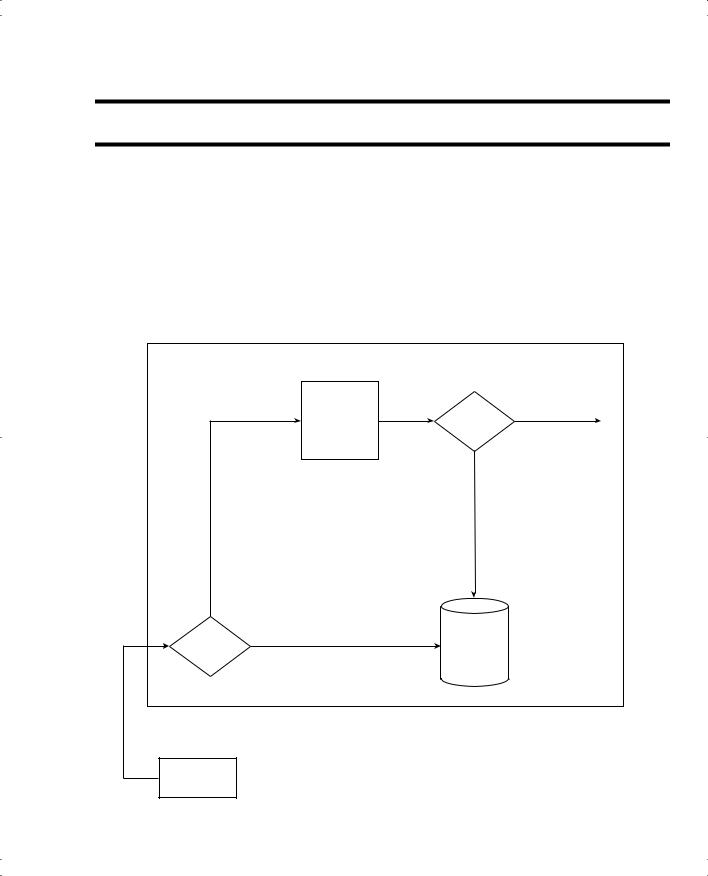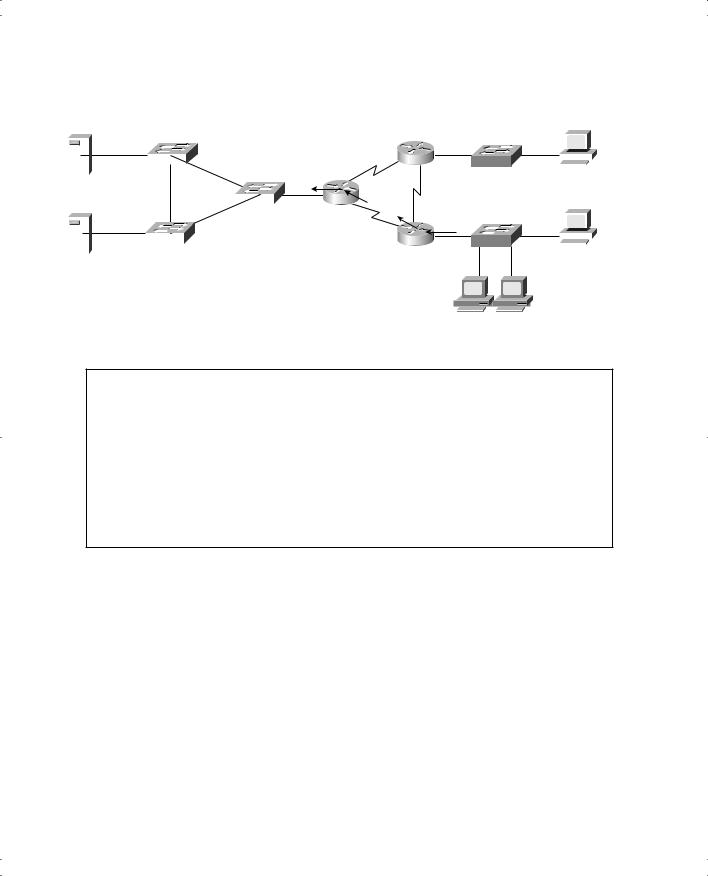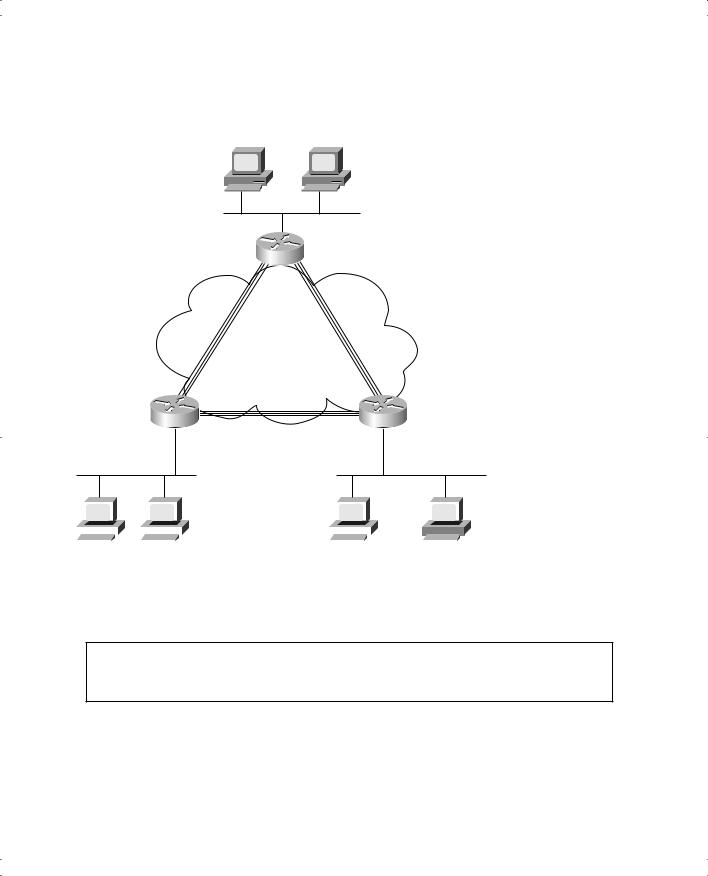
- •Warning and Disclaimer
- •Feedback Information
- •Trademark Acknowledgments
- •About the Author
- •About the Technical Reviewers
- •Dedication
- •Acknowledgments
- •Contents at a Glance
- •Contents
- •Icons Used in This Book
- •Command Syntax Conventions
- •Cisco’s Motivation: Certifying Partners
- •Format of the CCNA Exams
- •What’s on the CCNA Exams
- •ICND Exam Topics
- •Cross-Reference Between Exam Topics and Book Parts
- •CCNA Exam Topics
- •INTRO and ICND Course Outlines
- •Objectives and Methods
- •Book Features
- •How This Book Is Organized
- •Part I: LAN Switching
- •Part II: TCP/IP
- •Part III: Wide-Area Networks
- •Part IV: Network Security
- •Part V: Final Preparation
- •Part VI: Appendixes
- •How to Use These Books to Prepare for the CCNA Exam
- •For More Information
- •Part I: LAN Switching
- •“Do I Know This Already?” Quiz
- •Foundation Topics
- •Brief Review of LAN Switching
- •The Forward-Versus-Filter Decision
- •How Switches Learn MAC Addresses
- •Forwarding Unknown Unicasts and Broadcasts
- •LAN Switch Logic Summary
- •Basic Switch Operation
- •Foundation Summary
- •Spanning Tree Protocol
- •“Do I Know This Already?” Quiz
- •Foundation Topics
- •Spanning Tree Protocol
- •What IEEE 802.1d Spanning Tree Does
- •How Spanning Tree Works
- •Electing the Root and Discovering Root Ports and Designated Ports
- •Reacting to Changes in the Network
- •Spanning Tree Protocol Summary
- •Optional STP Features
- •EtherChannel
- •PortFast
- •Rapid Spanning Tree (IEEE 802.1w)
- •RSTP Link and Edge Types
- •RSTP Port States
- •RSTP Port Roles
- •RSTP Convergence
- •Edge-Type Behavior and PortFast
- •Link-Type Shared
- •Link-Type Point-to-Point
- •An Example of Speedy RSTP Convergence
- •Basic STP show Commands
- •Changing STP Port Costs and Bridge Priority
- •Foundation Summary
- •Foundation Summary
- •Virtual LANs and Trunking
- •“Do I Know This Already?” Quiz
- •Foundation Topics
- •Review of Virtual LAN Concepts
- •Trunking with ISL and 802.1Q
- •ISL and 802.1Q Compared
- •VLAN Trunking Protocol (VTP)
- •How VTP Works
- •VTP Pruning
- •Foundation Summary
- •Part II: TCP/IP
- •IP Addressing and Subnetting
- •“Do I Know This Already?” Quiz
- •Foundation Topics
- •IP Addressing Review
- •IP Subnetting
- •Analyzing and Interpreting IP Addresses and Subnets
- •Math Operations Used to Answer Subnetting Questions
- •Converting IP Addresses from Decimal to Binary and Back Again
- •The Boolean AND Operation
- •How Many Hosts and How Many Subnets?
- •What Is the Subnet Number, and What Are the IP Addresses in the Subnet?
- •Finding the Subnet Number
- •Finding the Subnet Broadcast Address
- •Finding the Range of Valid IP Addresses in a Subnet
- •Finding the Answers Without Using Binary
- •Easier Math with Easy Masks
- •Which Subnet Masks Meet the Stated Design Requirements?
- •What Are the Other Subnet Numbers?
- •Foundation Summary
- •“Do I Know This Already?” Quiz
- •Foundation Topics
- •Extended ping Command
- •Distance Vector Concepts
- •Distance Vector Loop-Avoidance Features
- •Route Poisoning
- •Split Horizon
- •Split Horizon with Poison Reverse
- •Hold-Down Timer
- •Triggered (Flash) Updates
- •RIP and IGRP
- •IGRP Metrics
- •Examination of RIP and IGRP debug and show Commands
- •Issues When Multiple Routes to the Same Subnet Exist
- •Administrative Distance
- •Foundation Summary
- •“Do I Know This Already?” Quiz
- •Foundation Topics
- •Link-State Routing Protocol and OSPF Concepts
- •Steady-State Operation
- •Loop Avoidance
- •Scaling OSPF Through Hierarchical Design
- •OSPF Areas
- •Stub Areas
- •Summary: Comparing Link-State and OSPF to Distance Vector Protocols
- •Balanced Hybrid Routing Protocol and EIGRP Concepts
- •EIGRP Loop Avoidance
- •EIGRP Summary
- •Foundation Summary
- •“Do I Know This Already?” Quiz
- •Foundation Topics
- •Route Summarization and Variable-Length Subnet Masks
- •Route Summarization Concepts
- •VLSM
- •Route Summarization Strategies
- •Sample “Best” Summary on Seville
- •Sample “Best” Summary on Yosemite
- •Classless Routing Protocols and Classless Routing
- •Classless and Classful Routing Protocols
- •Autosummarization
- •Classful and Classless Routing
- •Default Routes
- •Classless Routing
- •Foundation Summary
- •Advanced TCP/IP Topics
- •“Do I Know This Already?” Quiz
- •Foundation Topics
- •Scaling the IP Address Space for the Internet
- •CIDR
- •Private Addressing
- •Network Address Translation
- •Static NAT
- •Dynamic NAT
- •Overloading NAT with Port Address Translation (PAT)
- •Translating Overlapping Addresses
- •Miscellaneous TCP/IP Topics
- •Internet Control Message Protocol (ICMP)
- •ICMP Echo Request and Echo Reply
- •Destination Unreachable ICMP Message
- •Time Exceeded ICMP Message
- •Redirect ICMP Message
- •Secondary IP Addressing
- •FTP and TFTP
- •TFTP
- •MTU and Fragmentation
- •Foundation Summary
- •Part III: Wide-Area Networks
- •“Do I Know This Already?” Quiz
- •Foundation Topics
- •Review of WAN Basics
- •Physical Components of Point-to-Point Leased Lines
- •Data-Link Protocols for Point-to-Point Leased Lines
- •HDLC and PPP Compared
- •Looped Link Detection
- •Enhanced Error Detection
- •Authentication Over WAN Links
- •PAP and CHAP Authentication
- •Foundation Summary
- •“Do I Know This Already?” Quiz
- •Foundation Topics
- •ISDN Protocols and Design
- •Typical Uses of ISDN
- •ISDN Channels
- •ISDN Protocols
- •ISDN BRI Function Groups and Reference Points
- •ISDN PRI Function Groups and Reference Points
- •BRI and PRI Encoding and Framing
- •PRI Encoding
- •PRI Framing
- •BRI Framing and Encoding
- •DDR Step 1: Routing Packets Out the Interface to Be Dialed
- •DDR Step 2: Determining the Subset of the Packets That Trigger the Dialing Process
- •DDR Step 3: Dialing (Signaling)
- •DDR Step 4: Determining When the Connection Is Terminated
- •ISDN and DDR show and debug Commands
- •Multilink PPP
- •Foundation Summary
- •Frame Relay
- •“Do I Know This Already?” Quiz
- •Foundation Topics
- •Frame Relay Protocols
- •Frame Relay Standards
- •Virtual Circuits
- •LMI and Encapsulation Types
- •DLCI Addressing Details
- •Network Layer Concerns with Frame Relay
- •Layer 3 Addressing with Frame Relay
- •Frame Relay Layer 3 Addressing: One Subnet Containing All Frame Relay DTEs
- •Frame Relay Layer 3 Addressing: One Subnet Per VC
- •Frame Relay Layer 3 Addressing: Hybrid Approach
- •Broadcast Handling
- •Frame Relay Service Interworking
- •A Fully-Meshed Network with One IP Subnet
- •Frame Relay Address Mapping
- •A Partially-Meshed Network with One IP Subnet Per VC
- •A Partially-Meshed Network with Some Fully-Meshed Parts
- •Foundation Summary
- •Part IV: Network Security
- •IP Access Control List Security
- •“Do I Know This Already?” Quiz
- •Foundation Topics
- •Standard IP Access Control Lists
- •IP Standard ACL Concepts
- •Wildcard Masks
- •Standard IP ACL: Example 2
- •Extended IP Access Control Lists
- •Extended IP ACL Concepts
- •Extended IP Access Lists: Example 1
- •Extended IP Access Lists: Example 2
- •Miscellaneous ACL Topics
- •Named IP Access Lists
- •Controlling Telnet Access with ACLs
- •ACL Implementation Considerations
- •Foundation Summary
- •Part V: Final Preparation
- •Final Preparation
- •Suggestions for Final Preparation
- •Preparing for the Exam Experience
- •Final Lab Scenarios
- •Scenario 1
- •Scenario 1, Part A: Planning
- •Solutions to Scenario 1, Part A: Planning
- •Scenario 2
- •Scenario 2, Part A: Planning
- •Solutions to Scenario 2, Part A: Planning
- •Part VI: Appendixes
- •Glossary
- •Answers to the “Do I Know This Already?” Quizzes and Q&A Questions
- •Chapter 1
- •“Do I Know This Already?” Quiz
- •Chapter 2
- •“Do I Know This Already?” Quiz
- •Chapter 3
- •“Do I Know This Already?” Quiz
- •Chapter 4
- •“Do I Know This Already?” Quiz
- •Chapter 5
- •“Do I Know This Already?” Quiz
- •Chapter 6
- •“Do I Know This Already?” Quiz
- •Chapter 7
- •“Do I Know This Already?” Quiz
- •Chapter 8
- •“Do I Know This Already?” Quiz
- •Chapter 9
- •“Do I Know This Already?” Quiz
- •Chapter 10
- •“Do I Know This Already?” Quiz
- •Chapter 11
- •“Do I Know This Already?” Quiz
- •Chapter 12
- •“Do I Know This Already?” Quiz
- •Using the Simulation Software for the Hands-on Exercises
- •Accessing NetSim from the CD
- •Hands-on Exercises Available with NetSim
- •Scenarios
- •Labs
- •Listing of the Hands-on Exercises
- •How You Should Proceed with NetSim
- •Considerations When Using NetSim
- •Routing Protocol Overview
- •Comparing and Contrasting IP Routing Protocols
- •Routing Through the Internet with the Border Gateway Protocol
- •RIP Version 2
- •The Integrated IS-IS Link State Routing Protocol
- •Summary of Interior Routing Protocols
- •Numbering Ports (Interfaces)

Foundation Summary 449
Foundation Summary
The “Foundation Summary” section lists the most important facts from the chapter. Although this section does not list everything that will be on the exam, a well-prepared CCNA candidate should at a minimum know all the details in each Foundation Summary before taking the exam.
Figure 12-7 shows the basic logic behind where an ACL can perform its filtering logic inside a router.
Figure 12-7 Locations Where Access List Logic Can Be Applied on Router R1
Router R1
|
|
Permit |
Routing |
Outbound |
Permit |
E0 |
|
|
|
Logic |
|
||
|
|
|
ACL |
|
|
|
|
|
|
|
|
|
|
|
|
|
|
Deny |
|
|
S1 |
Inbound |
Deny |
|
Bit |
|
|
|
|
|
|
|
||
|
ACL |
|
|
Bucket |
|
|
IP Packet

450 Chapter 12: IP Access Control List Security
The logic that Cisco IOS software uses with a multiple-entry ACL can be summarized as follows:
1.The matching parameters of the access-list statement are compared to the packet.
2.If a match is made, the action defined in this access-list statement (permit or deny) is performed.
3.If a match is not made in Step 2, repeat Steps 1 and 2 using each successive statement in the ACL until a match is made.
4.If no match is made with an entry in the access list, the deny action is performed.
Table 12-9 summarizes the different fields that can be matched with an extended IP ACL, as compared with standard IP ACLs.
Table 12-9 |
Standard and Extended IP Access Lists: Matching |
|
|
|
|
|
Type of Access List |
What Can Be Matched |
|
|
|
|
Both Standard and Extended ACLs |
Source IP address |
|
|
|
|
|
Portions of the source IP address using a wildcard mask |
|
|
|
|
Only Extended ACLs |
Destination IP address |
|
|
|
|
|
Portions of the destination IP address using a wildcard |
|
|
mask |
|
|
|
|
|
Protocol type (TCP, UDP, ICMP, IGRP, IGMP, and |
|
|
others) |
|
|
|
|
|
Source port |
|
|
|
|
|
Destination port |
|
|
|
|
|
All TCP flows except the first |
|
|
|
|
|
IP TOS |
|
|
|
|
|
IP precedence |
|
|
|

Foundation Summary 451
Table 12-10 lists several sample access-list commands, with several options configured and some explanations.
Table 12-10 Extended access-list Commands and Logic Explanations
access-list Statement |
What It Matches |
|
|
access-list 101 deny ip any host 10.1.1.1 |
Any IP packet, any source IP |
|
address, with a destination |
|
IP address of 10.1.1.1. |
|
|
access-list 101 deny tcp any gt 1023 host 10.1.1.1 eq 23 |
Packets with a TCP header, |
|
any source IP address, with a |
|
source port greater than (gt) |
|
1023. The packet must have a |
|
destination IP address of |
|
10.1.1.1 and a destination port |
|
of 23. |
|
|
access-list 101 deny tcp any host 10.1.1.1 eq 23 |
The same as the preceding |
|
example, but any source port |
|
matches, because that |
|
parameter is omitted in this |
|
case. |
|
|
access-list 101 deny tcp any host 10.1.1.1 eq telnet |
The same as the preceding |
|
example. The telnet keyword is |
|
used instead of port 23. |
|
|
access-list 101 deny udp 1.0.0.0 0.255.255.255 lt 1023 any |
A packet with a source in |
|
network 1.0.0.0, using UDP |
|
with a source port less than (lt) |
|
1023, with any destination IP |
|
address. |
|
|
Figure 12-8 and Example 12-11 demonstrate a sample configuration of a numbered extended IP ACL. In this case, Bob is denied access to all FTP servers on R1’s Ethernet, and Larry is denied access to Server1’s web server.

452 Chapter 12: IP Access Control List Security
Figure 12-8 Network Diagram for Extended Access List
Server1 |
|
|
|
|
|
|
|
|
|
Larry |
|||||
|
|
|
|
|
|
|
|
|
|
|
|
|
|||
|
|
|
|
|
|
|
|
S0 R2 |
|
|
|
|
|
|
|
|
|
|
|
|
|
|
|
|
|
|
|
|
|
|
|
|
|
|
SW2 |
|
|
|
E0 |
SW12 |
|
|
|
|
|
||
|
|
|
|
|
|
|
|
|
|||||||
|
|
|
|
|
|
|
S0 |
S1 |
|
172.16.2.10 |
|||||
|
|
|
|
|
|
|
|
||||||||
172.16.1.100 |
|
|
|
|
|
|
|
|
|
|
|
|
|||
|
|
|
|
|
|
|
|
|
|
|
|
|
|||
|
|
|
|
|
|
|
E0 R1 |
|
|
|
|
|
|
|
|
Server2 |
|
|
|
SW1 |
|
|
|
|
Bob |
||||||
|
|
|
|
S1 |
S1 |
|
|
|
|||||||
|
|
|
|
|
|
|
|
|
|
|
|
|
|
|
|
|
|
|
|
|
|
|
|
S0 |
|
|
|
|
|
|
|
|
|
|
|
|
|
|
|
|
|
|
|
|
|
|
|
|
|
|
|
|
|
|
|
|
|
|
|
|
|
|
|
|
|
|
SW3 |
|
|
|
R3 |
E0 |
SW13 |
|
|
|
|
||
|
|
|
|
|
|
|
|
|
|
172.16.3.10 |
|||||
|
|
|
|
|
|
|
|
|
|
||||||
172.16.1.102
Jimmy Jerry
172.16.3.8 172.16.3.9
Example 12-11 R1’s Extended Access List
interface Serial0
ip address 172.16.12.1 255.255.255.0 ip access-group 101 in
interface Serial1
ip address 172.16.13.1 255.255.255.0 ip access-group 101 in
access-list 101 remark Stop Bob to FTP servers, and Larry to Server1 web access-list 101 deny tcp host 172.16.3.10 172.16.1.0 0.0.0.255 eq ftp access-list 101 deny tcp host 172.16.2.10 host 172.16.1.100 eq http access-list 101 permit ip any any
Cisco makes the following general recommendations, as mentioned in the ICND course:
■Create your ACLs using a text editor outside the router, and copy and paste the configurations into the router.
■Place extended ACLs as close to the source of the packet as possible to discard the packets quickly.
■Place standard ACLs as close to the destination of the packet as possible, because standard ACLs often discard packets that you do not want discarded when placed close to the source.
■Place more-specific statements early in the ACL.
■Disable ACLs from their interfaces (using the no ip access-group command) before making changes to the ACL.

Q&A 453
Q&A
As mentioned in the Introduction, you have two choices for review questions. The following questions give you a bigger challenge than the exam because they are open-ended. By reviewing with this more-difficult question format, you can exercise your memory better and prove your conceptual and factual knowledge of the topics covered in this chapter. The answers to these questions are found in Appendix A.
For more practice with exam-like question formats, including multiple-choice questions and those using a router simulator, use the exam engine on the CD.
1.Configure a numbered IP access list that stops packets from subnet 134.141.7.0 255.255.255.0 from exiting serial 0 on a router. Allow all other packets.
2.Configure an IP access list that allows only packets from subnet 193.7.6.0 255.255.255.0, going to hosts in network 128.1.0.0 and using a web server in 128.1.0.0, to enter serial 0 on a router.
3.How would a user who does not have the enable password find out what access lists have been configured and where they are enabled?
4.Configure and enable an IP access list that stops packets from subnet 10.3.4.0/24 from exiting serial interface S0 and that stops packets from 134.141.5.4 from entering S0. Permit all other traffic.
5.Configure and enable an IP access list that allows packets from subnet 10.3.4.0/24, to any web server, to exit serial interface S0. Also allow packets from 134.141.5.4 going to all TCP-based servers using a well-known port to enter serial 0. Deny all other traffic.
6.Can standard IP access lists be used to check the source IP address when enabled with the ip access-group 1 in command, and can they check the destination IP addresses when using the ip access-group 1 out command?
7.True or false: If all IP access-list statements in a particular list define the deny action, the default action is to permit all other packets.
8.How many IP access lists of either type can be active on an interface at the same time?
For questions 10 through 12, assume that all parts of the network shown in Figure 12-9 are up and working. IGRP is the IP routing protocol in use. Answer the questions following Example 12-12, which contains an additional configuration in the Mayberry router.

454 Chapter 12: IP Access Control List Security
Figure 12-9 Network Diagram for Questions 10 Through 12
Andy Opie
180.3.5.13180.3.5.14
|
Subnet 180.3.5.0/24 |
|
Mayberry |
s0 |
|
|
Frame Relay |
|
Full Mesh |
Subnet 180.3.6.0/24 |
|
s0 |
s0 |
Mount Pilot |
Raleigh |
Subnet 180.3.7.0/24 |
Subnet 144.155.3.0/24 |
|
|
|
|
|
|
|
|
|
|
|
|
|
|
|
|
|
|
|
|
|
|
|
|
|
|
|
|
|
|
|
|
|
|
|
|
|
|
|
|
|
|
|
|
|
|
|
|
|
|
|
|
|
|
|
|
|
|
|
|
|
|
|
|
|
|
|
|
|
|
|
|
|
|
|
|
|
|
|
|
Beatrice |
|
Floyd |
Barney |
|
Governor |
||||||||||||||
|
|
|
|
|
|
|
|
|
|
|
|
|
|
144.155.3.99 |
|||||
Example 12-12 Access List at Mayberry
access-list 44 permit 180.3.5.13 0.0.0.0
!
interface serial 0
ip access-group 44 out
9.Describe the types of packets that this filter discards, and specify at what point they are discarded.
10.Does the access list shown in Example 12-12 stop packets from getting to web server Governor? Why or why not?

Q&A 455
11.Referring to Figure 12-9, create and enable access lists so that access to web server Governor is allowed from hosts at any site and so that no other access to hosts in Raleigh is allowed.
12.Name all the items that a standard IP access list can examine to make a match.
13.Name all the items that an extended IP access list can examine to make a match.
14.True or false: When you use extended IP access lists to restrict vty access, the matching logic is a best match of the list rather than a first match in the list.
15.In a standard numbered IP access list with three statements, a no version of the first statement is issued in configuration mode. Immediately following, another access list configuration command is added for the same access list. How many statements are in the list now, and in what position is the newly added statement?
16.In a standard named IP access list with three statements, a no version of the first statement is issued in configuration mode. Immediately following, another access list configuration command is added for the same access list. How many statements are in the list now, and in what position is the newly added statement?
17.Name all the items that a named standard IP access list can examine to make a match.
18.Configure a named IP access list that stops packets from subnet 134.141.7.0 255.255.255.0 from exiting serial 0 on a router. Allow all other packets.
19.Configure a named IP access list that allows only packets from subnet 193.7.6.0 255.255.255.0, going to hosts in network 128.1.0.0 and using a web server in 128.1.0.0, to enter serial 0 on a router.
20.List the types of IP access lists (numbered standard, numbered extended, named standard, named extended) that can be enabled to prevent Telnet access into a router. What commands would be used to enable this function, assuming that access-list 2 was already configured to match the right packets?
21.What command lists the IP extended access lists enabled on serial 1 without showing other interfaces?
22.Name all the items that a named extended IP access list can examine to make a match.

